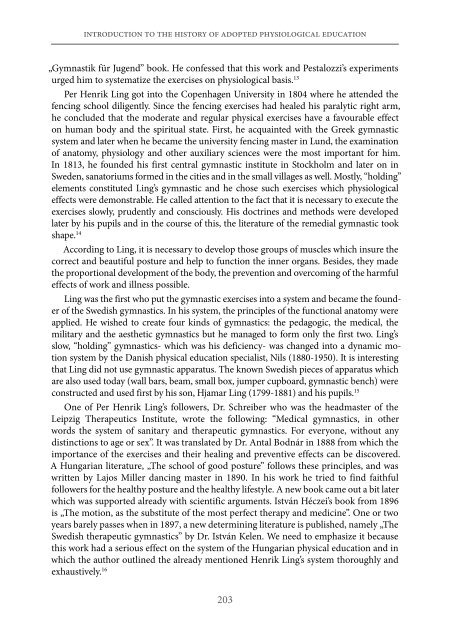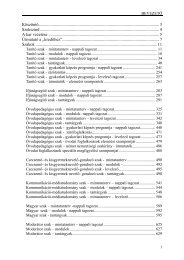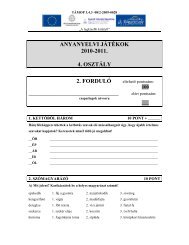ACTA SZEKSZARDIENSIUM - Pécsi Tudományegyetem Illyés Gyula ...
ACTA SZEKSZARDIENSIUM - Pécsi Tudományegyetem Illyés Gyula ...
ACTA SZEKSZARDIENSIUM - Pécsi Tudományegyetem Illyés Gyula ...
You also want an ePaper? Increase the reach of your titles
YUMPU automatically turns print PDFs into web optimized ePapers that Google loves.
introduction to the history of adopted physiological education<br />
„Gymnastik für Jugend” book. He confessed that this work and Pestalozzi’s experiments<br />
urged him to systematize the exercises on physiological basis. 13<br />
Per Henrik Ling got into the Copenhagen University in 1804 where he attended the<br />
fencing school diligently. Since the fencing exercises had healed his paralytic right arm,<br />
he concluded that the moderate and regular physical exercises have a favourable effect<br />
on human body and the spiritual state. First, he acquainted with the Greek gymnastic<br />
system and later when he became the university fencing master in Lund, the examination<br />
of anatomy, physiology and other auxiliary sciences were the most important for him.<br />
In 1813, he founded his first central gymnastic institute in Stockholm and later on in<br />
Sweden, sanatoriums formed in the cities and in the small villages as well. Mostly, “holding”<br />
elements constituted Ling’s gymnastic and he chose such exercises which physiological<br />
effects were demonstrable. He called attention to the fact that it is necessary to execute the<br />
exercises slowly, prudently and consciously. His doctrines and methods were developed<br />
later by his pupils and in the course of this, the literature of the remedial gymnastic took<br />
shape. 14<br />
According to Ling, it is necessary to develop those groups of muscles which insure the<br />
correct and beautiful posture and help to function the inner organs. Besides, they made<br />
the proportional development of the body, the prevention and overcoming of the harmful<br />
effects of work and illness possible.<br />
Ling was the first who put the gymnastic exercises into a system and became the founder<br />
of the Swedish gymnastics. In his system, the principles of the functional anatomy were<br />
applied. He wished to create four kinds of gymnastics: the pedagogic, the medical, the<br />
military and the aesthetic gymnastics but he managed to form only the first two. Ling’s<br />
slow, “holding” gymnastics- which was his deficiency- was changed into a dynamic motion<br />
system by the Danish physical education specialist, Nils (1880-1950). It is interesting<br />
that Ling did not use gymnastic apparatus. The known Swedish pieces of apparatus which<br />
are also used today (wall bars, beam, small box, jumper cupboard, gymnastic bench) were<br />
constructed and used first by his son, Hjamar Ling (1799-1881) and his pupils. 15<br />
One of Per Henrik Ling’s followers, Dr. Schreiber who was the headmaster of the<br />
Leipzig Therapeutics Institute, wrote the following: “Medical gymnastics, in other<br />
words the system of sanitary and therapeutic gymnastics. For everyone, without any<br />
distinctions to age or sex”. It was translated by Dr. Antal Bodnár in 1888 from which the<br />
importance of the exercises and their healing and preventive effects can be discovered.<br />
A Hungarian literature, „The school of good posture” follows these principles, and was<br />
written by Lajos Miller dancing master in 1890. In his work he tried to find faithful<br />
followers for the healthy posture and the healthy lifestyle. A new book came out a bit later<br />
which was supported already with scientific arguments. István Héczei’s book from 1896<br />
is „The motion, as the substitute of the most perfect therapy and medicine”. One or two<br />
years barely passes when in 1897, a new determining literature is published, namely „The<br />
Swedish therapeutic gymnastics” by Dr. István Kelen. We need to emphasize it because<br />
this work had a serious effect on the system of the Hungarian physical education and in<br />
which the author outlined the already mentioned Henrik Ling’s system thoroughly and<br />
exhaustively. 16<br />
203




